Overview
This article highlights various customer modeling strategies that small businesses can implement to enhance engagement and foster loyalty. We understand the challenges you face in connecting with your customers, and it’s crucial to recognize the impact of personalized communication, feedback loops, and tailored experiences. Statistics show that engaged clients are significantly more likely to make repeat purchases, which ultimately contributes to higher revenue.
Imagine how your business could thrive if each customer felt uniquely valued. By creating personalized interactions, you can build stronger relationships that encourage loyalty. Consider how feedback loops allow you to listen to your customers’ needs, tailoring their experiences to meet their expectations.
As you reflect on these strategies, think about how implementing them can transform your customer relationships. Engaging clients in a meaningful way not only enhances their experience but also drives your business success. Together, we can achieve a deeper connection with your audience, leading to lasting loyalty and growth.
Introduction
In a landscape where customer expectations are constantly evolving, we understand that small businesses face the challenge of adapting to these changes. To enhance engagement and build lasting relationships, it’s essential to adopt innovative strategies. By leveraging customer modeling techniques, you can gain valuable insights into client preferences, leading to more personalized interactions that foster improved satisfaction.
However, with so many approaches available, determining which strategies will truly resonate with your customers can be daunting. How can small enterprises effectively navigate this complex terrain to boost engagement and drive success? Together, we can explore solutions that empower you to connect with your audience on a deeper level.
Wayy.ai: AI-Powered Client Acquisition for Streamlined Lead Generation
Wayy.ai is here to support small enterprises in their journey toward success. This innovative platform harnesses advanced AI technology to transform the client acquisition process, allowing you to focus on what you do best while achieving remarkable sales outcomes. Imagine automating your outreach efforts—this means more time for your primary activities and less stress in your daily operations.
With features like a one-click sales playbook and tailored outreach plans, Wayy.ai empowers you to effortlessly create target client profiles using customer modeling. Picture connecting with over 60 potential clients each month, significantly enhancing your sales pipeline without the hassle of manual intervention. This automation not only saves you valuable time but also increases the likelihood of successful conversions by engaging prospects at just the right moment.
We understand the challenges you face in lead generation, and Wayy.ai stands out as a vital tool in streamlining this process. Together, we can maximize your sales potential and help you achieve your business goals. Why not take the next step and explore how Wayy.ai can make a difference for you?
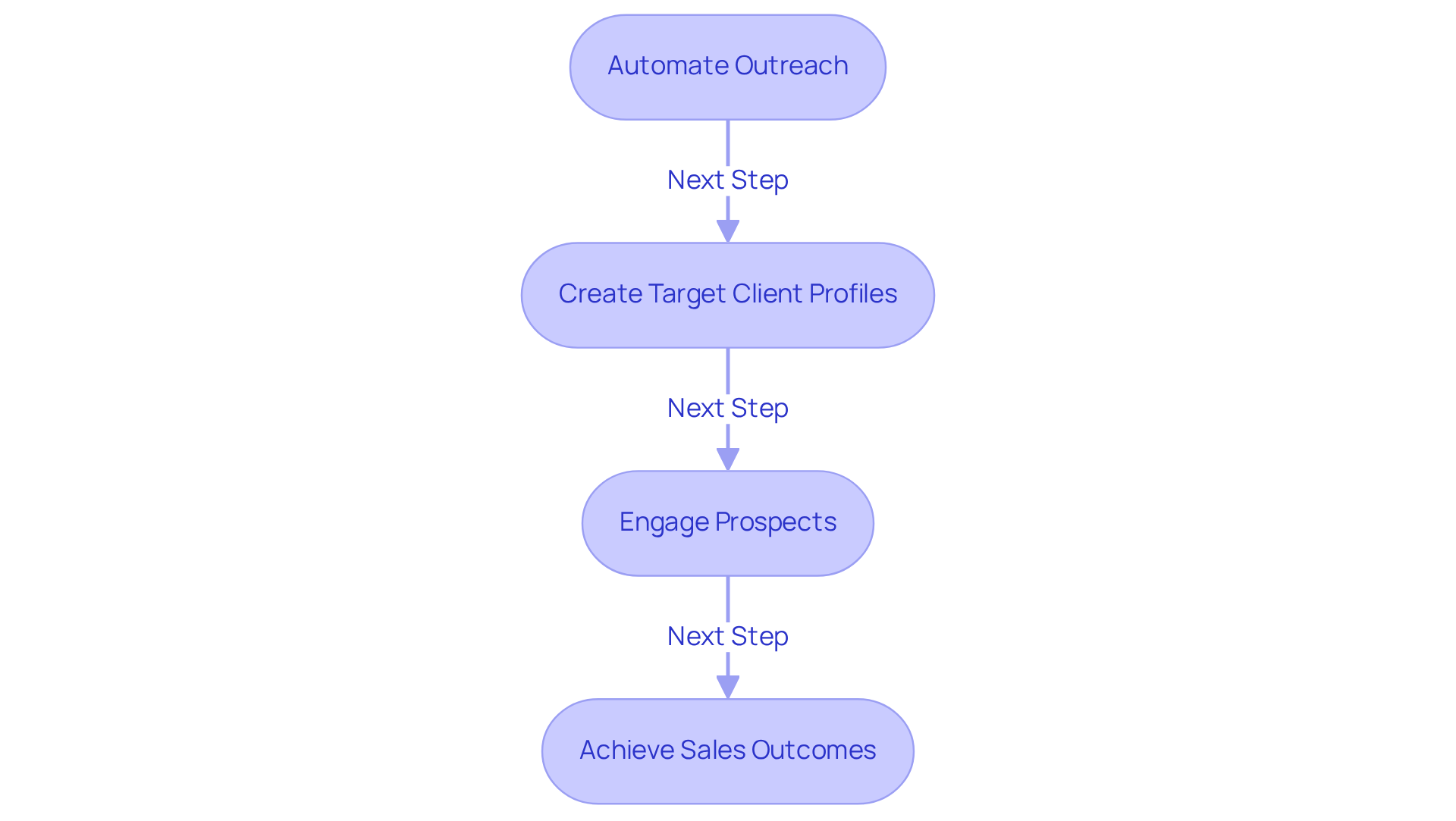
Customer Engagement Model: Strategies for Effective Customer Interaction
A strong customer modeling engagement model is essential for small businesses like yours that aim to enhance interactions with consumers. Have you considered how customer modeling, along with personalized communication, regular feedback loops, and data analytics, can help you understand your clients' preferences? Tailored communication significantly influences client contentment; in fact, 70% of consumers indicate that a company's understanding of their unique needs impacts their loyalty. By actively seeking client feedback, you can refine your offerings and adjust your messaging to better align with customer modeling that reflects their needs and expectations.
For instance, firms that prioritize tailored experiences report a 20% increase in client contentment and involvement. Engaged clients, in turn, spend between 20% and 40% more than those who are less involved. This approach to customer modeling nurtures a stronger bond with your clients and fosters commitment—engaged clients are 64% more likely to make repeat purchases. Moreover, every 1% increase in client contentment can lead to a 5% rise in retention rates.
Implementing these strategies creates a more engaging experience that resonates with your audience. Together, we can enhance satisfaction and cultivate long-term loyalty. By focusing on these key strategies, you’re not just improving your business; you’re building a community of satisfied clients who feel valued and understood.
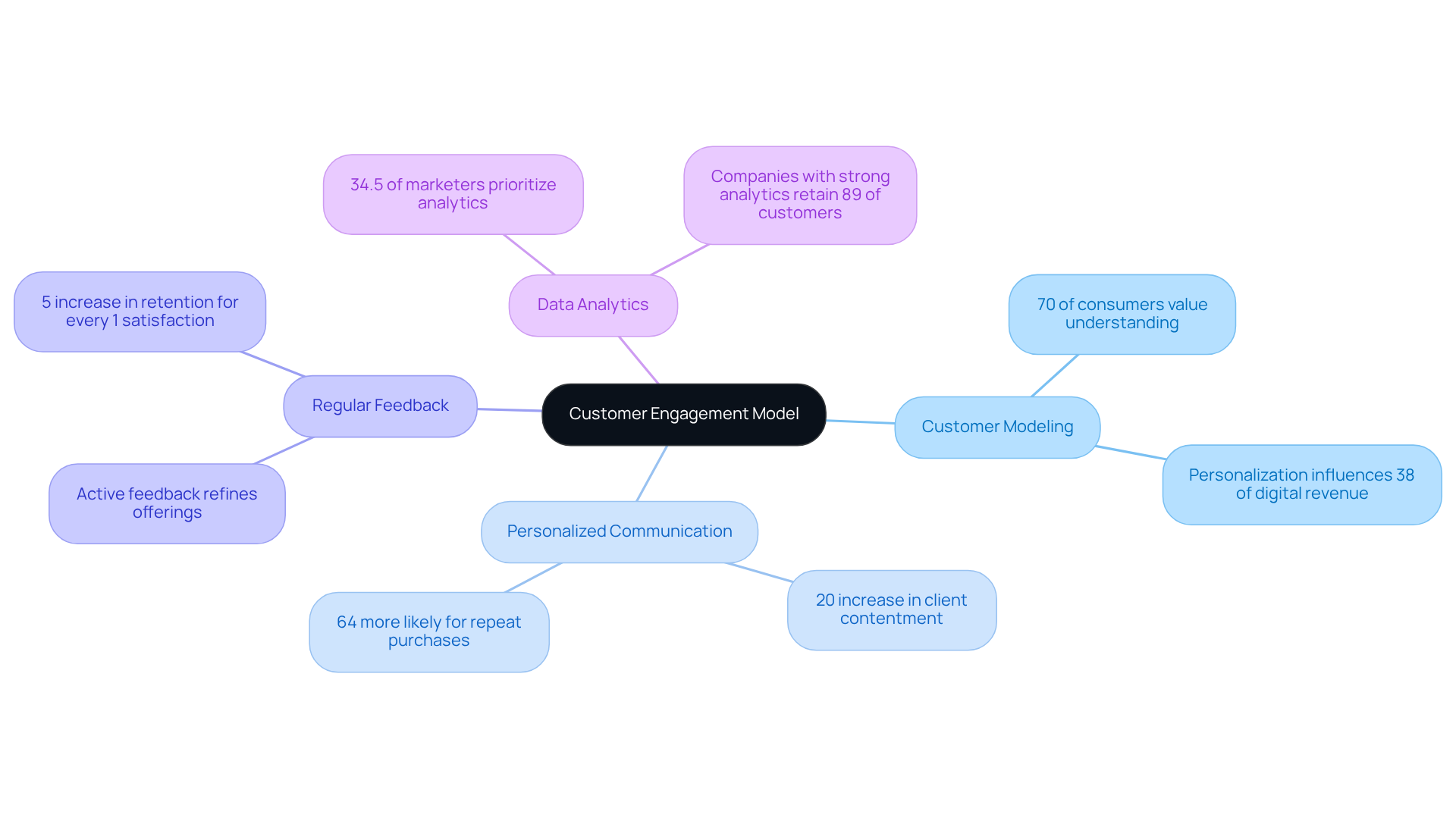
Customer Co-Creation Models: Innovating with Customer Input
Client co-creation models actively engage clients in the product development process, allowing them to share their ideas and feedback. This collaborative approach not only leads to offerings that resonate more deeply with the target audience but also enhances customer modeling, strengthening relationships with clients.
Have you considered how workshops or surveys could help you gather valuable insights on new products? By utilizing customer modeling to ensure your offerings align with client needs and preferences, you nurture loyalty and build a community around your brand, promoting sustainable growth.
As Tony Hsieh pointed out, '86% of buyers are willing to pay more for a better experience.' This statistic highlights the financial advantages of prioritizing consumer feedback. Furthermore, as Annette Franz mentioned, "client experience is the only genuine differentiator." Firms that excel in client experience increase revenue 80% faster than their rivals. This emphasizes the competitive edge you can achieve through effective customer modeling in engaging clients during product development.
Together, we can create experiences that not only satisfy but also delight your clients.
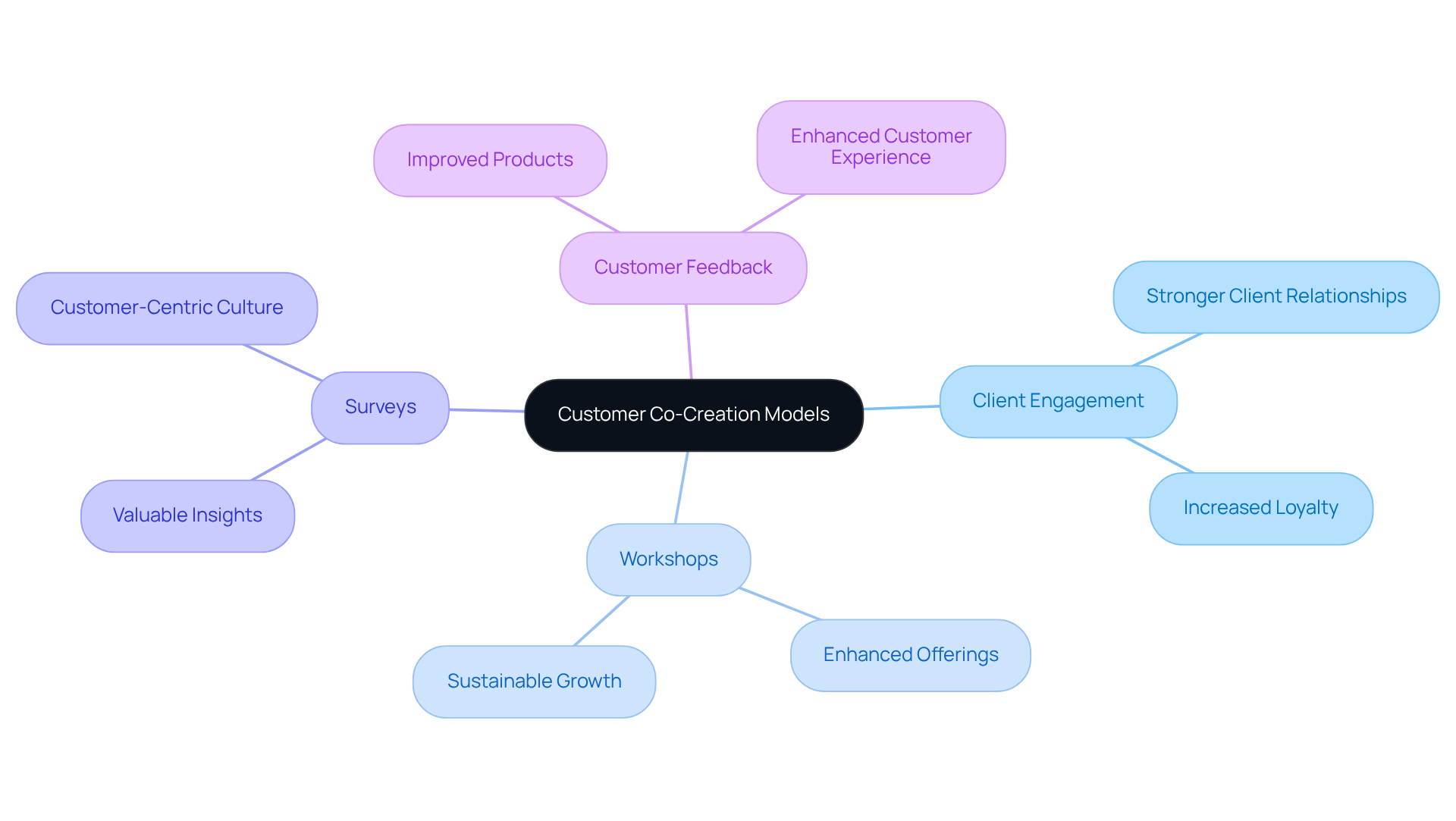
Customer Service Model: Building Effective Support Strategies
An effective service model is essential for small enterprises aiming to enhance customer modeling, client satisfaction, and loyalty. Have you ever considered how much a caring approach can transform client interactions? Training staff to provide empathetic support significantly enhances client experiences. In fact, a staggering 86% of clients are willing to abandon a brand after just two unsatisfactory experiences. This statistic underscores the vital nature of service interactions.
Implementing multi-channel communication options—like live chat, email, and social media—supports customer modeling by allowing businesses to engage with clients where they are. This not only provides prompt assistance but also elevates contentment levels. Did you know that live chat boasts a satisfaction rate of 79%, compared to 61% for email and 44% for phone support? These figures highlight the importance of accessibility in client service.
As Damon Richards wisely stated, "Customers do not care how much you know unless they know how much you care." Establishing clear protocols for managing inquiries and complaints ensures that client issues are addressed promptly and effectively. By prioritizing these service strategies, companies can utilize customer modeling to create positive experiences that encourage repeat patronage and foster long-term brand loyalty. Together, we can achieve success by making our clients feel valued and understood.
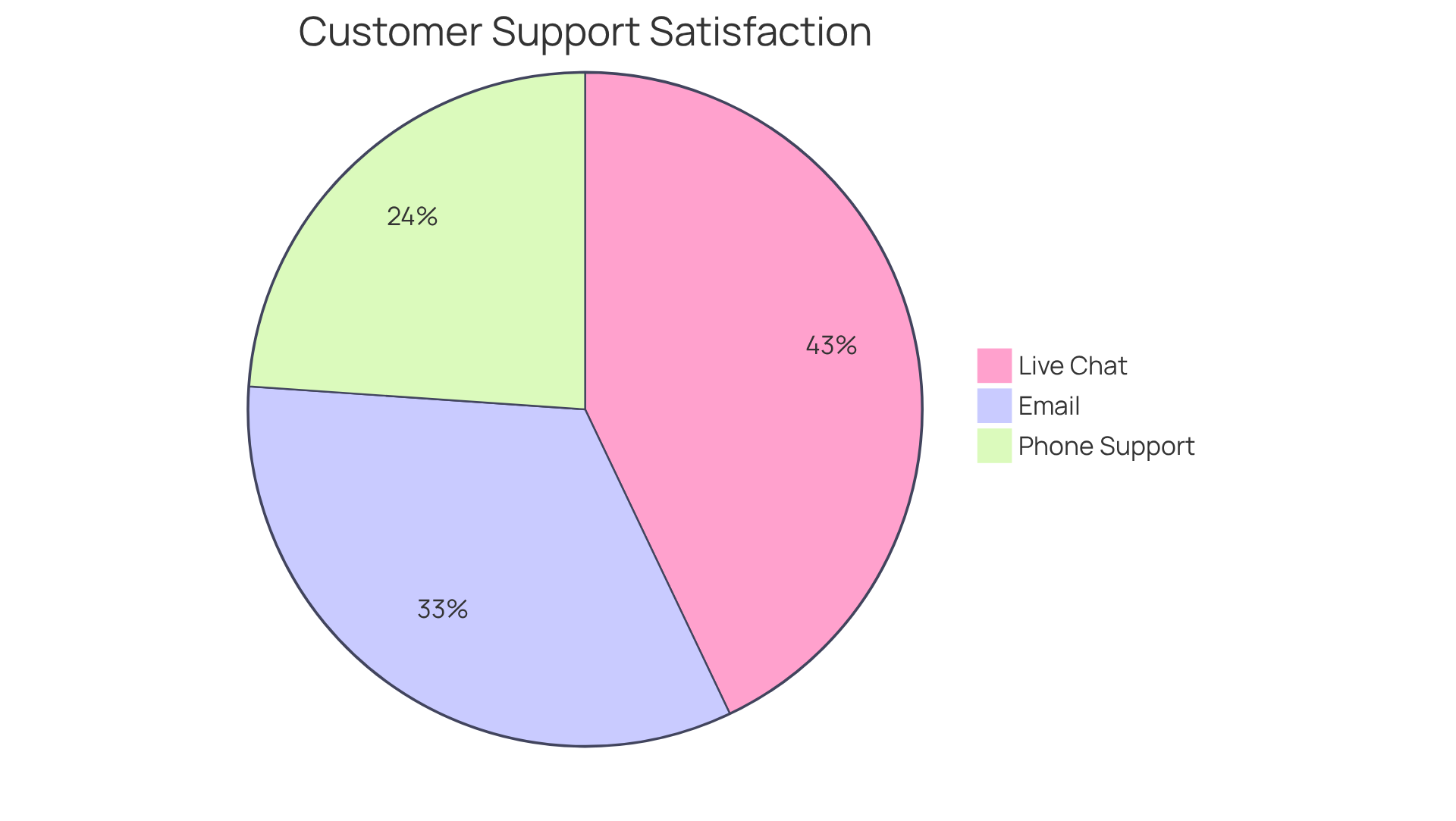
Process Models for Customer Journey: Enhancing Customer Experience
Charting the client journey is an essential step for small enterprises eager to improve customer modeling. By visualizing each touchpoint, we can identify pain points and areas for improvement. This process involves gathering information on client interactions, analyzing feedback, and refining procedures to ensure a seamless experience.
For instance, think about how journey mapping can streamline onboarding processes. This simplification makes it easier for new clients to engage with your products or services. Imagine the relief of clients feeling welcomed and understood right from the start. This proactive approach not only boosts client satisfaction but also increases the likelihood of repeat transactions.
Together, we can transform these insights into actionable steps that empower your business. By utilizing customer modeling to focus on your clients’ needs and experiences, you’re not just improving your services; you’re fostering lasting relationships that drive success.
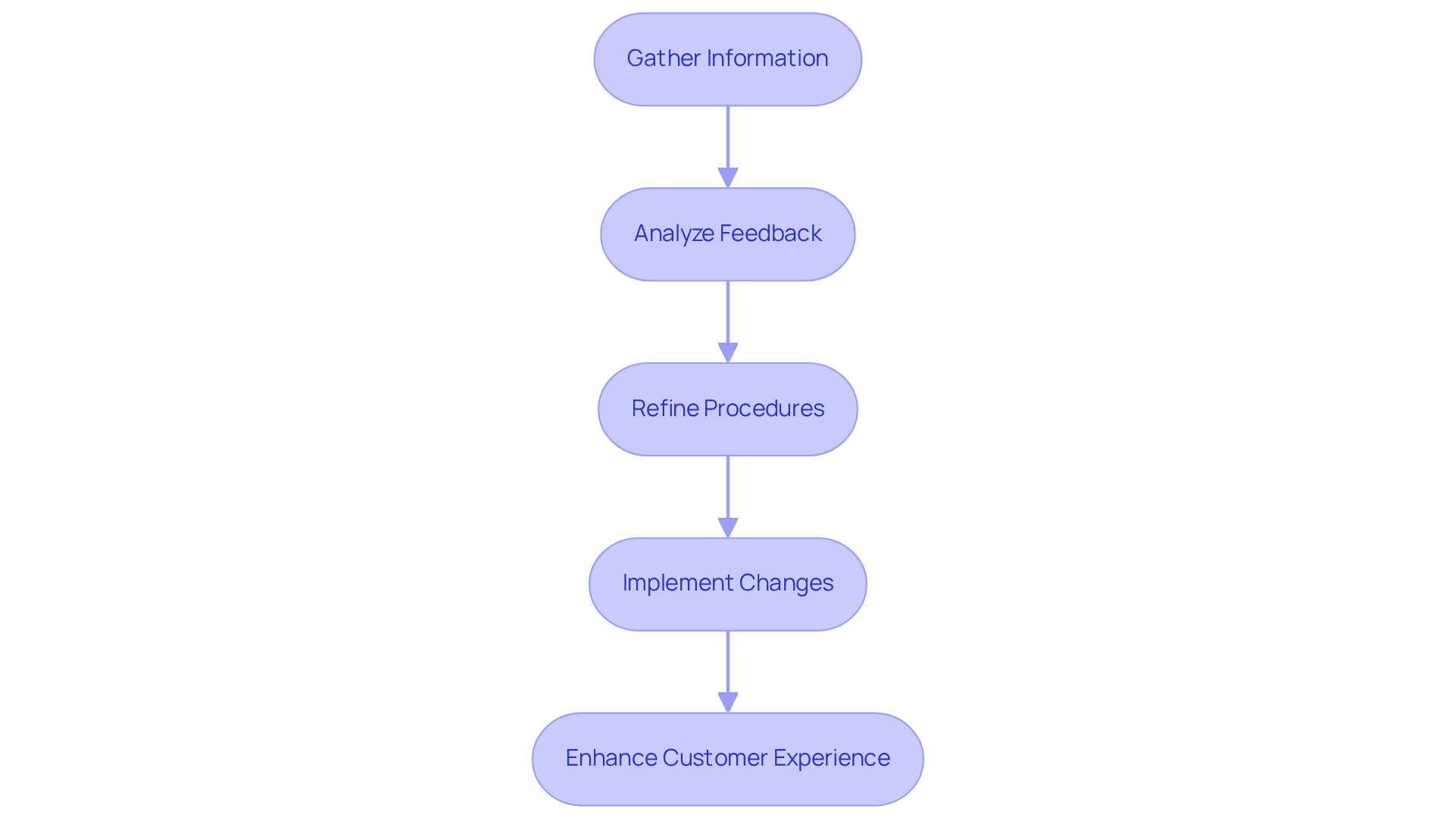
High-Touch Engagement Model: Fostering Personalized Customer Relationships
The high-touch engagement model emphasizes personalized interactions between companies and their clients, utilizing customer modeling to dedicate resources that cultivate strong relationships. By designating account managers or client success representatives to key clients, businesses can ensure customized assistance and proactive communication. Have you considered how tailored follow-up messages after a purchase can significantly enhance the client experience? This approach not only results in heightened loyalty but also encourages repeat transactions.
In fact, 80% of consumers are more inclined to buy from brands that offer personalized experiences. Additionally, 88% of individuals who trust a store are likely to return as repeat purchasers. This model is particularly advantageous for small enterprises striving to stand out in a competitive market, as it nurtures a sense of worth and connection that resonates deeply with clients.
By investing in tailored interactions that incorporate customer modeling, companies can enhance client satisfaction and foster long-term loyalty. It's worth noting that nearly half of consumers report that inadequate support directly impacts their retention. Together, we can create a supportive environment that not only meets client needs but also builds lasting relationships.
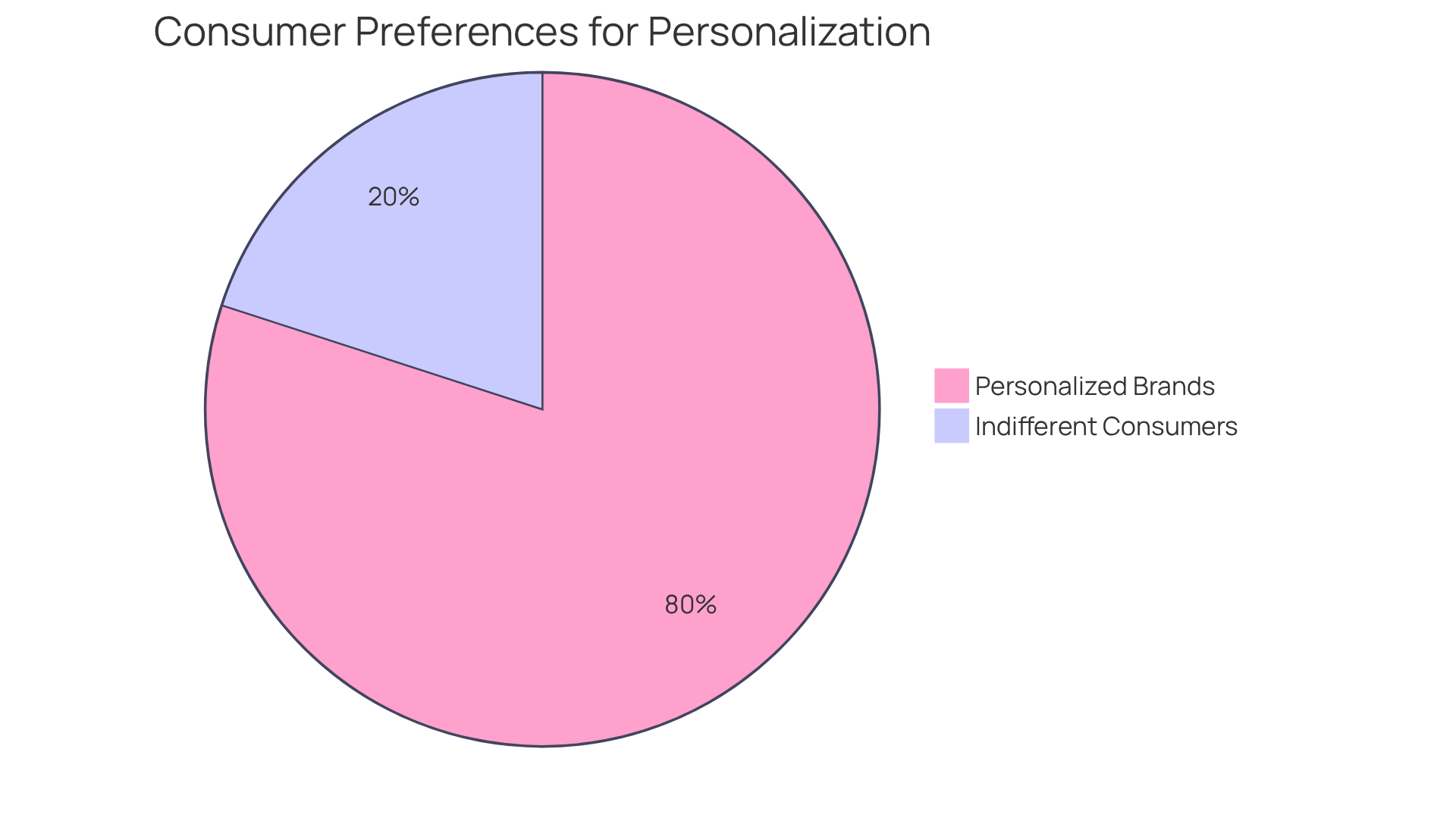
Low-Touch Engagement Model: Efficient Customer Interaction Strategies
In today's fast-paced world, the low-touch engagement model can truly transform how small businesses interact with their clients. By prioritizing efficiency and scalability, this approach leverages automation and self-service tools to enhance interactions. Imagine being able to reach a wider audience without compromising the quality of service you provide. This is particularly beneficial for small enterprises with limited resources.
One effective tactic is deploying chatbots to manage client inquiries. These intelligent tools can independently address up to 86% of questions, significantly reducing response times and increasing customer satisfaction. Additionally, AI can automate up to 43% of support tasks, further streamlining your operations. Have you considered how offering detailed FAQs and utilizing email automation for follow-ups can enhance your efficiency? This not only helps maintain high levels of client satisfaction but also allows you to manage expenses effectively.
It's worth noting that 84% of organizations report that AI improves the speed of issue resolution. This statistic reinforces the effectiveness of these technologies in fostering better client relationships. By implementing automated solutions, small enterprises like yours can enhance client interactions and operational effectiveness, ultimately nurturing growth and loyalty.
We understand your challenges, and integrating AI chatbots into your service strategy could be a significant step toward enhancing both efficiency and client satisfaction. Together, we can achieve success in creating a more responsive and supportive environment for your clients.
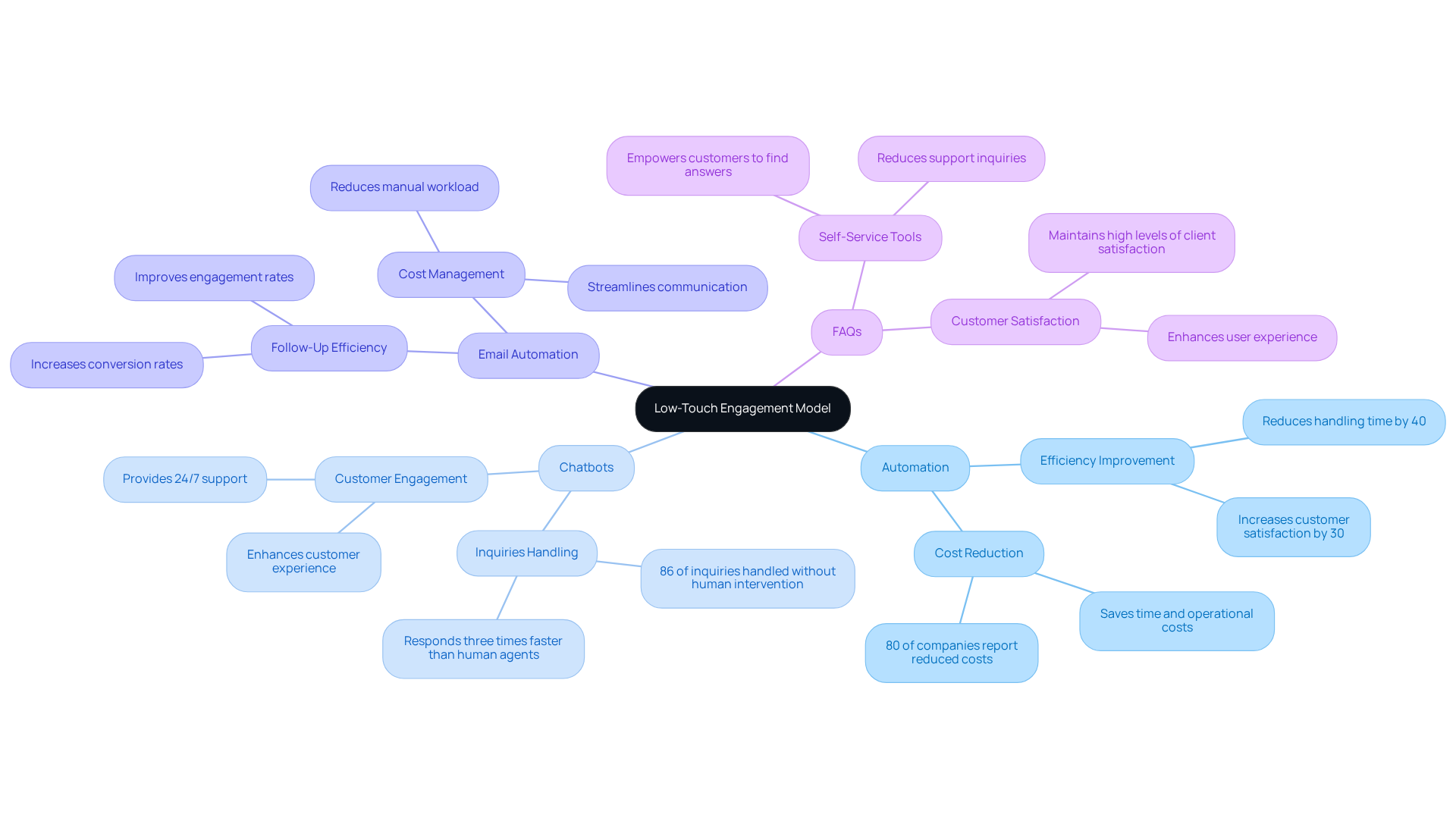
Retention Models: Strategies for Keeping Customers Engaged
Customer modeling through retention models is essential for small businesses striving to maintain client engagement and reduce churn. One of the most effective strategies is introducing rewards programs, which not only encourage repeat purchases but also foster a sense of belonging among clients. For instance, tiered reward programs can offer returning patrons exclusive discounts or early access to new products, significantly enhancing their overall experience. Research indicates that:
- 84% of consumers are more likely to stay with a brand that offers rewards.
- 90% of loyalty programs yield positive ROI.
This underscores the importance of these programs in cultivating loyalty.
Moreover, customer modeling shows that personalized incentives are vital for retention. By tailoring rewards to individual preferences, businesses can greatly boost satisfaction and engagement; tailored product suggestions can increase retention by 30%. Regularly seeking client feedback is another key tactic in customer modeling; it allows businesses to adapt their services to meet client needs, leading to improved retention rates. In fact, companies that actively collect and respond to client feedback can enhance retention by up to 14%.
The impact of loyalty programs on customer modeling is significant for client retention in small businesses. Research shows that customer modeling reveals returning clients can account for up to 65% of a company's revenue, highlighting the financial benefits of nurturing long-term relationships. As Akash Cillanki, Director of Demand Generation, notes:
- "Focusing on client retention can greatly enhance profits while reducing expenses."
- "Recognizing that your clients will return repeatedly alleviates the stress of ongoing advertising expenses."
By prioritizing commitment programs, small businesses can create a sustainable growth strategy that not only retains patrons but also inspires them to become brand advocates. Furthermore, simplicity in loyalty program design is crucial; as noted, "simplicity is the secret weapon to making loyalty programs profitable.
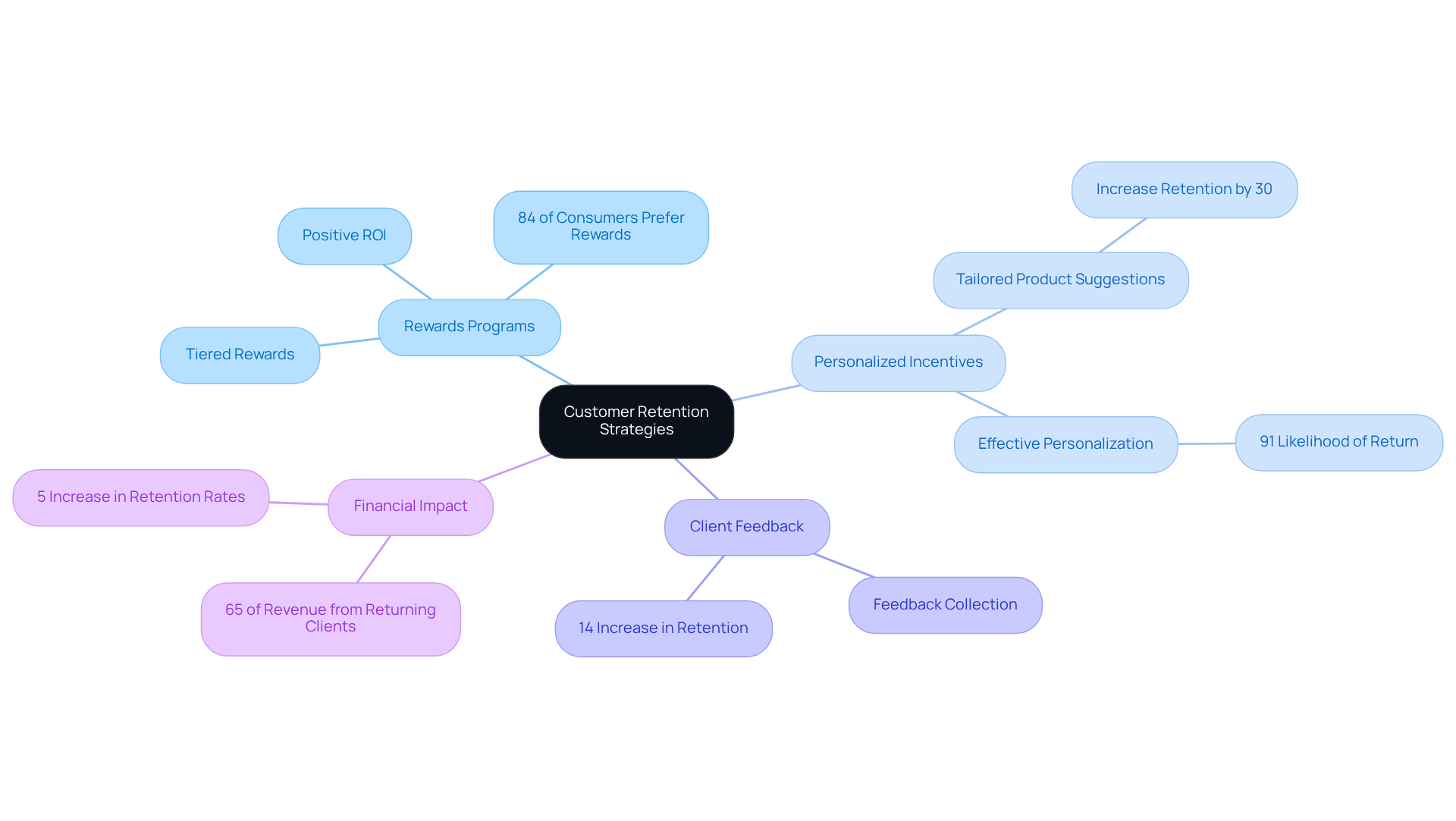
Customer Success Manager Model: Ensuring Customer Satisfaction
The client success manager (CSM) model is all about ensuring that clients achieve their desired outcomes while using a company's products or services. CSMs act as advocates for clients, providing support throughout their journey and addressing any challenges that may arise. Have you ever felt overwhelmed while trying to navigate a new service? By proactively engaging with clients, CSMs can uncover opportunities for upselling or cross-selling, ultimately boosting satisfaction and loyalty.
For example, regular check-ins with clients allow CSMs to understand their evolving needs and tailor solutions accordingly. This not only fosters a deeper relationship but also empowers clients to feel heard and valued. Together, we can navigate these challenges and create a path to success.
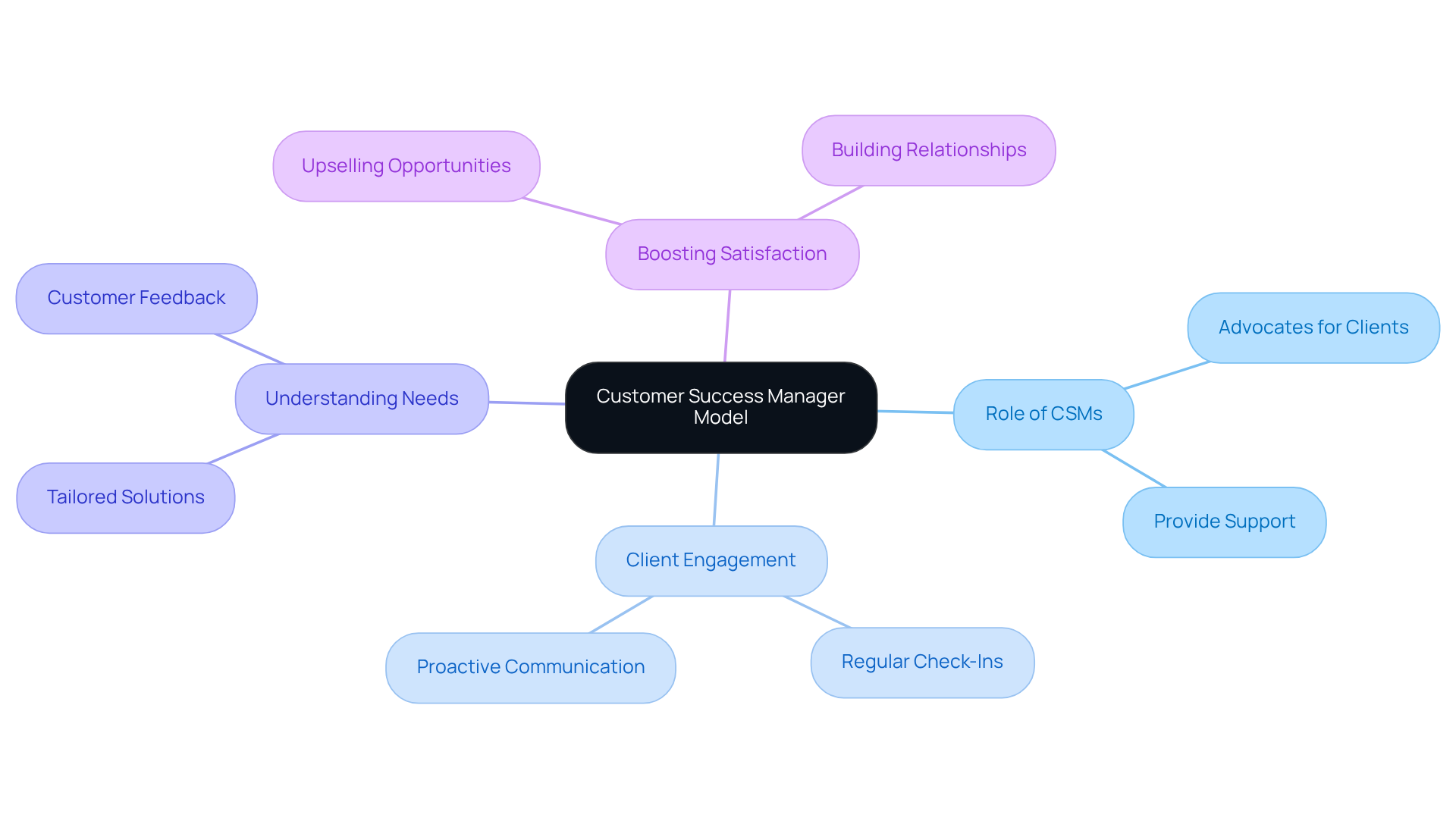
Hybrid Engagement Models: Tailoring Strategies for Diverse Customer Needs
Hybrid engagement models effectively combine high-touch and low-touch strategies to address the varied requirements of clients. This approach not only enables businesses to offer personalized support to high-value clients but also allows for automation in broader interactions. For instance, imagine a company assigning dedicated account managers to its most important clients, ensuring they receive tailored attention. At the same time, chatbots can efficiently handle general inquiries.
In fact, did you know that 68% of respondents from client-focused firms prioritize personalizing interactions across multiple touchpoints in an individual's journey? This dual strategy not only improves client satisfaction but also guarantees that all patrons receive the appropriate level of support. Engaged clients spend up to 67% more, demonstrating that enterprises adopting customized engagement strategies can significantly enhance loyalty and drive growth.
To effectively implement these hybrid engagement strategies, small business owners should start by utilizing customer modeling to map their customer journey. This process helps identify key touchpoints for personalization, ensuring that every interaction feels meaningful. Together, we can create a more supportive environment that meets the unique needs of each client.
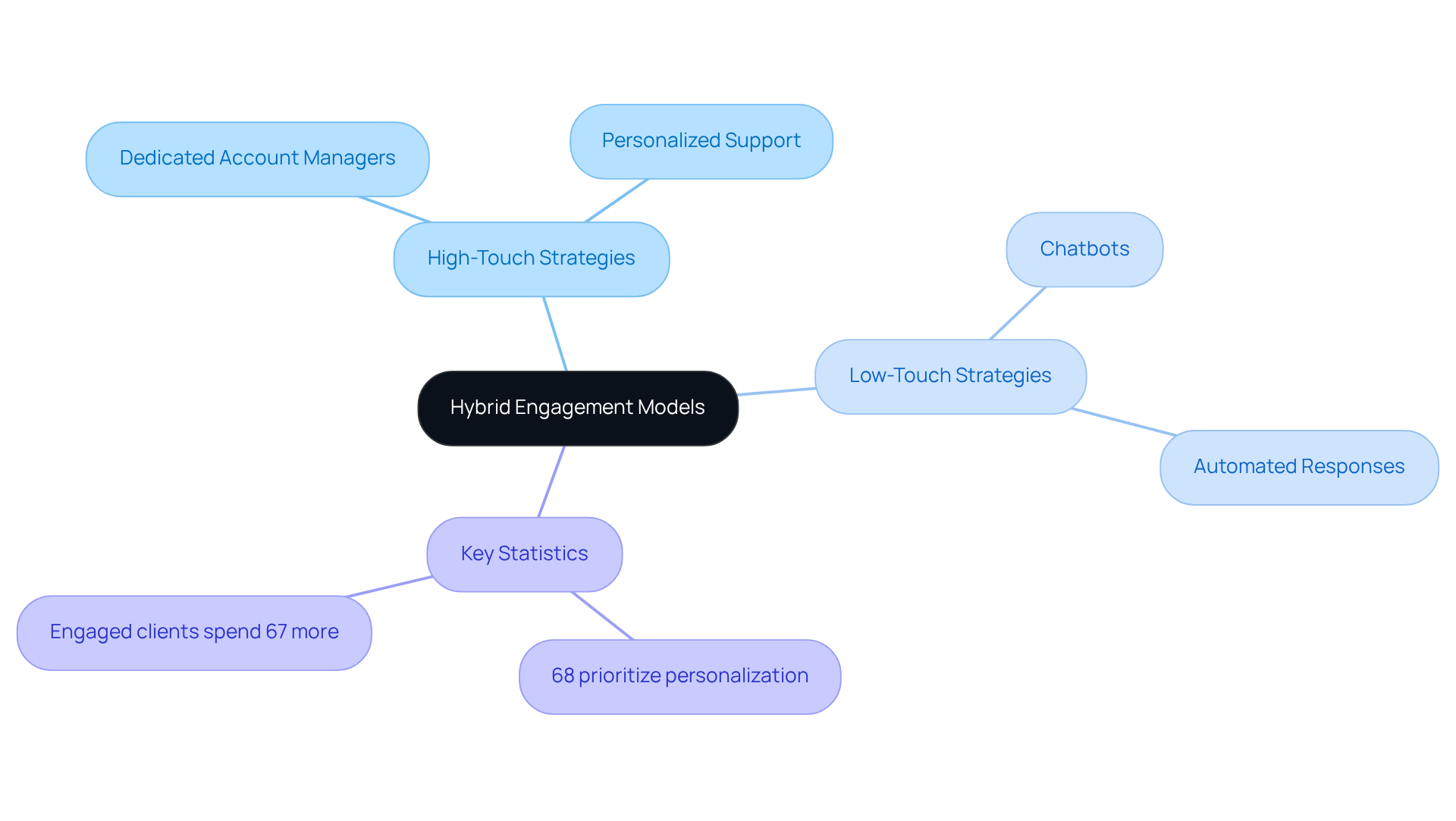
Conclusion
Embracing effective customer modeling strategies is essential for small businesses looking to enhance engagement and nurture lasting relationships with their clients. By understanding and implementing these strategies, we can create personalized experiences that not only meet customer needs but also foster loyalty and satisfaction.
This article highlights several key approaches:
- The significance of tailored communication
- The value of customer co-creation
- The effectiveness of service models
Each of these plays a vital role in enriching customer interactions. With tools like Wayy.ai, businesses can automate lead generation and streamline client acquisition, allowing them to focus on building meaningful connections. Furthermore, strategies such as hybrid engagement models and retention programs underscore the necessity of adapting to diverse customer needs while creating a supportive environment.
Ultimately, prioritizing customer engagement through these innovative strategies can lead to significant growth and success for small businesses. As the landscape continues to evolve, embracing these techniques will not only enhance client satisfaction but also cultivate a community of loyal customers who feel valued and understood. By taking action now to implement these strategies, we can lay the foundation for a thriving business that truly resonates with its audience.
Frequently Asked Questions
What is Wayy.ai and how does it assist small enterprises?
Wayy.ai is an AI-powered platform designed to support small enterprises in client acquisition and lead generation. It automates outreach efforts, allowing businesses to focus on their core activities while achieving better sales outcomes.
What features does Wayy.ai offer for lead generation?
Wayy.ai includes features such as a one-click sales playbook and tailored outreach plans, enabling users to create target client profiles through customer modeling. It helps connect with over 60 potential clients each month, enhancing the sales pipeline without manual intervention.
How does Wayy.ai improve the client acquisition process?
By automating outreach efforts and engaging prospects at optimal times, Wayy.ai saves time and increases the likelihood of successful conversions, ultimately streamlining the client acquisition process.
What is the importance of a customer engagement model for small businesses?
A strong customer engagement model is crucial for enhancing interactions with consumers. It involves personalized communication, regular feedback loops, and data analytics to understand client preferences, which significantly influences client satisfaction and loyalty.
How does tailored communication impact client loyalty?
Tailored communication can greatly affect client loyalty, with 70% of consumers indicating that a company's understanding of their unique needs impacts their loyalty. Firms that prioritize tailored experiences see a 20% increase in client contentment and engagement.
What are the benefits of engaged clients?
Engaged clients tend to spend 20% to 40% more than less engaged clients and are 64% more likely to make repeat purchases. Additionally, a 1% increase in client contentment can lead to a 5% rise in retention rates.
What are customer co-creation models and their significance?
Customer co-creation models involve actively engaging clients in the product development process, allowing them to share ideas and feedback. This approach leads to offerings that resonate more with the target audience and strengthens relationships with clients.
How can businesses gather insights for product development?
Businesses can use workshops or surveys to gather valuable insights from clients about new products. This helps ensure that offerings align with client needs and preferences, promoting loyalty and sustainable growth.
What financial advantages come from prioritizing consumer feedback?
Prioritizing consumer feedback can lead to significant financial benefits, as 86% of buyers are willing to pay more for a better experience. Companies that excel in client experience increase revenue 80% faster than their competitors.
How can effective customer modeling enhance business growth?
Effective customer modeling fosters stronger client relationships and engagement, which leads to improved client satisfaction, loyalty, and ultimately, sustainable business growth.




